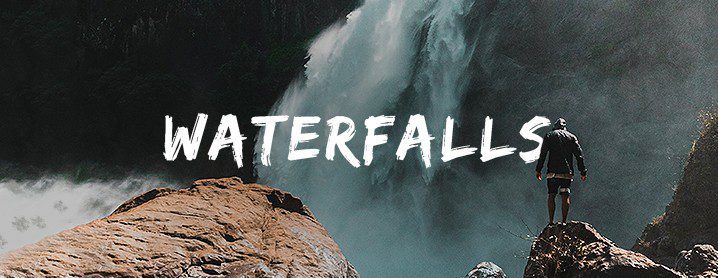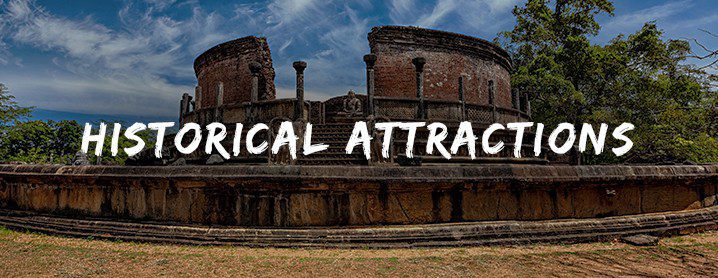
5 well-known Buddhist temples in Sri Lanka
There are many important places in Sri Lanka worthy of exploring amongst which the temples located all over the island are a must visit. Sri Lanka has been a Buddhist country since the 3rd century BCE and Theravada Buddhism was declared as the state religion.
With this, many temples and learning centres were built by kings and rulers of the island. While everyone is familiar with the sacred Temple of the Tooth Relic, here are some noteworthy Buddhist temples in Sri Lanka.
Ruwanweliseya
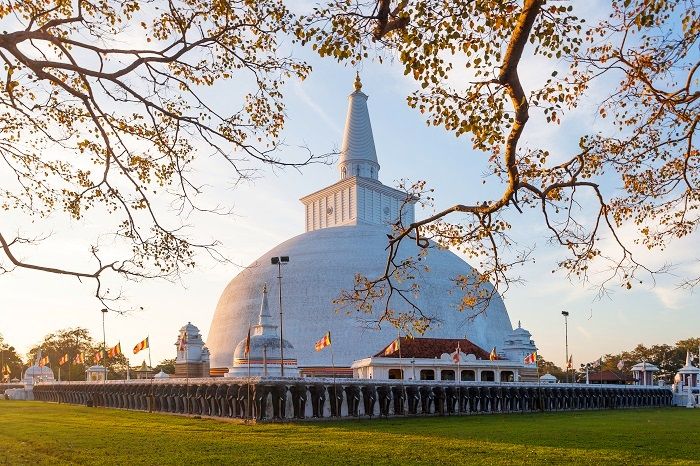
Most sacred Ruwanweliseya stupa was originally built in 140 B.C by King Dutugemunu
Considered as one of the Solosmasthana* and Atamasthana*, Ruwanweliseya is located in Anuradhapura. Built by King Dutugemunu in 140 BC, it is also known as Swarnamali Chaithya, Maha Stupa, Hemamali Chaithya and Rathnamali Dagoba.
It has been renovated over the years and in 1902, the Ruwanweli Seya Restoration Society was founded.
Though the construction was started by King Dutugemunu, unfortunately, he didn’t live until the completion of the stupa and his brother King Saddhatissa completed the remaining work. This gleaming white stupa is visited by pilgrims from all over the world.
Visitors could also spot a few statues made out of granite of King Dutugemunu, King Bhathika Tissa, and Queen Vihara Mahadevi around the stupa. It is a known fact that Kaunghmudaw Pagoda in Myanmar was built to resemble the Ruwanweliseya.
*Solosmasthana – 16 places of veneration
*Atamasthana – 08 places of veneration
Read more about stupa construction in Sri Lanka ➡ Ancient Stupas in Sri Lanka
Quick Facts
- Location: Anuradhapura (6.3 km from Anuradhapura town) [ Google Maps ]
- Constructed by: King Dutugamunu
- Built in: 144 BC
- Renovations: Pioneered by Venerable Naranvita Sumanasara Thera in 1873
- Height: 338 ft.
- Circumference: 951 ft.
[Reference: Swarnamali Maha Seya and the forgotten monk]
Dambulla Cave Temple
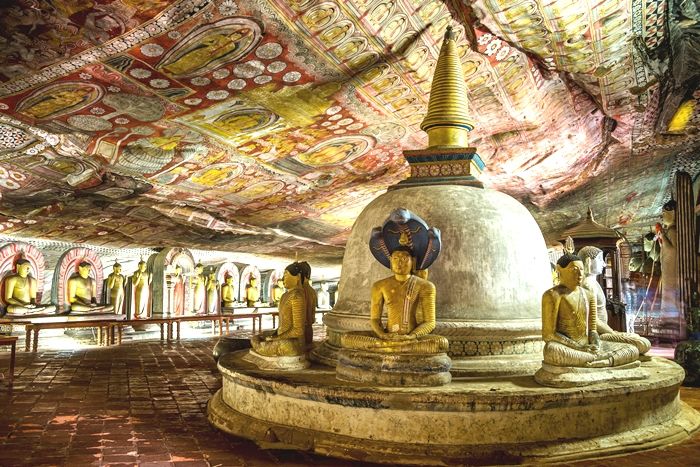
Exquisite artworks and statues in Dambulla cave temple
A place of worship since 1st century BCE, Dambulla Cave Temple located in the central parts of the isle houses colourful and intricate paintings as well as various statues. These paintings include images of Buddha, bodhisattvas, gods and goddesses.
This rock cave complex also known as the Golden Temple of Dambulla was also named as a UNESCO World Heritage Site. An area of 23,000 sq.ft. is covered by paintings of the Buddha and his life story.
The complex consists of 5 caves, which are listed below:
i. Cave of the Divine King
Also known as the “Devaraja Lena” locally consists of a 14m statue of Buddha. Ananda Thero, buddha’s favourite pupil sits below the statue and a statue of god Vishnu. The entrance of the cave contains a Brahmi inscription which is believed to be dating back to the 1st century.
ii. Cave of the Great Kings
The largest of the five, contains 16 standing Buddha statues, 40 seated statues as well as statues of gods Vishnu and Saman. Apart from these statues of Kings Vattagamini and Nissanka Malla are also placed in the cave. Locally, this cave is named as “Maharaja Lena”. It also contains a spring known to have healing powers. Important events are drawn in the ceiling above.
iii. Great New Monastery
Wall paintings inside this cave are done in a typical Kandyan style and were painted during the reign of King Kirthi Sri Rajasinghe (1747–1782). There are 50 Buddha statues as well as a statue of the king inside this cave known as “Maha Alut Vihara”.
iv. Fourth and Fifth Caves
The fourth and fifth caves are smaller in size compared to the others and contain paintings and sculptures which was done at a later period.
Quick Facts
- Location: Dambulla (2.7km from Dambulla town) [ Google Maps ]
- No. of Caves: 5
- No. of Statues: 153 Buddha statues, 4 statues of gods/goddesses and 3 statues of kings
- Constructed by: King Walagamba (103 BC – 77 BC)
3. Kalutara Temple
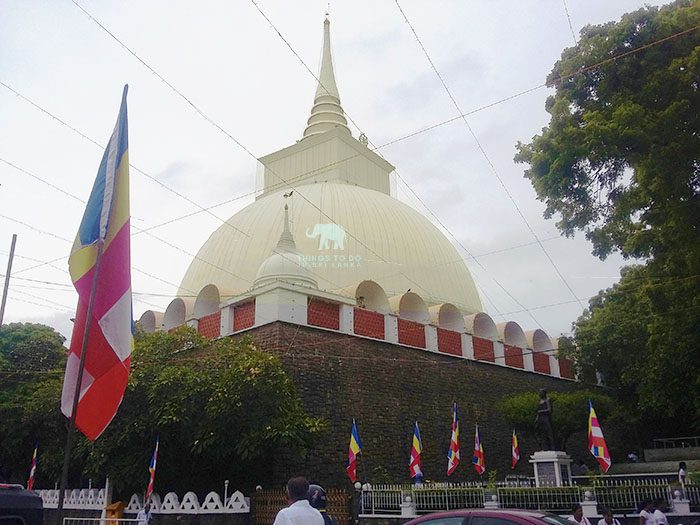
Kalutara Chaithya is a pioneering project of Sri Lankan structural engineering.
Located in the immediate south of the Kalutara bridge, this temple is a place of worship visited by many heading to the southern coast of Sri Lanka. The sacred Kalutara Chaithya is one of the few hollow stupas of the world and the first hollow stupa in Sri Lanka.
This means you can enter into the stupa unlike other stupas you’ll find scattered around the island. The interior contains paintings that depict various stages of Buddha’s life and previous lives. There is a small stupa within in which sacred relics are enshrined.
Visitors to this religious site can walk inside and observe the murals and the statues. Adjoining the stupa is the sacred Kalutara Bodhiya, this Bo tree (Fig tree) sprouted from one of the 32 saplings of the sacred Jaya Sri Maha Bodhiya in Anuradhapura.
There is another Bodhi tree right by the Galle road (lower terrace) which is equally sacred. It is one of the 08 saplings of Kataragama Bodhiya which is a sapling of Jaya Sri Maha Bodhi in Bodhgaya.
Piqued your interest? Read more about historical attraction in Kalutara ➡ Cultural and Historical Monuments in Kalutara
Quick Facts about Kalutara Chaithya (Stupa)
- Location: Kalutara (190m from the town) [ Google Maps ]
- The pinnacle laid on 1974
- Height: 185 ft.
- Diameter: 100 ft.
- Circumference: 300 ft.
- Commissioned by: Sir Cyril de Zoysa
- Architect: Justin Samarasekera
- Engineer: Dr A.N.S. Kulasinghe
- Constructed by: State Engineering Corporation (Reference)
Quick Facts about Kalutara Bodhiya (Sacred fig tree)
- Upper Terrace
- Origin: Jaya Sri Maha Bodhi, Anuradhapura
- Age (approx): 2,200 years (It is considered the Bodhi tree was planted around 200BC by the orders of King Dewanampiya Tissa)
- Lower Terrace (By the Galle Road)
- Origin: Kataragama Ashtapala Bodhi tree
- Planted by: Chola King Wickrama Pandya
- Planted in: 1052 AD
4. Mahiyanganaya Temple
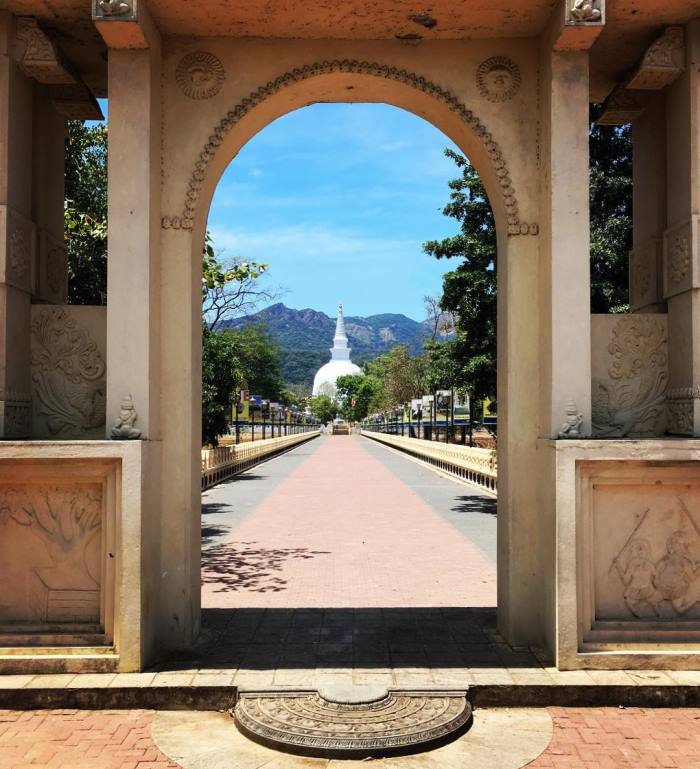
Mahiyanganaya Dagoba looms ahead surrounded by lofty hills | Photo Credit: Gihan Kuruppu
The Mahiyanganaya Raja Maha Viharaya is constructed in the site believed to be the first visit by The Lord Buddha. It is also part of the Solosmasthana* and was declared as an archaeological site in Sri Lanka. This was the first stupa built in the island and it enshrines a handful of Buddha’s hair as well as the left collar bone.
The stupa was built by the chief of demon worshippers (Yakkah) after attaining the 1st phase of spiritual eminence (Sothapanna) listening to dharma preached by Lord Buddha. He is now considered a deity who guards over the Adams peak (God Maha Sumana Saman). Upon requesting a token from Buddha to worship in his absence, a handful of hair was given to the chief who in turn built a small stupa to place them.
In 543 BC, buddha’s left collar bone was brought to the site and the relic was enshrined in the stupa which was enlarged to 18ft. Over the years, various kings have renovated the stupa. Duththagamini or king Dutugamunu renovated the stupa to its current height of 120 ft. during his reign.
*Solosmasthana – 16 places of veneration
Quick Facts
- Location: Mahiyanganaya (4.4km from the town) [ Google Maps ]
- Height: 120 ft.
- First constructed: By Yakka chieftain Saman during 500-600 BC
- Relics enshrined: A flock of hair and left collar-bone of Lord Buddha
5. Mihintale
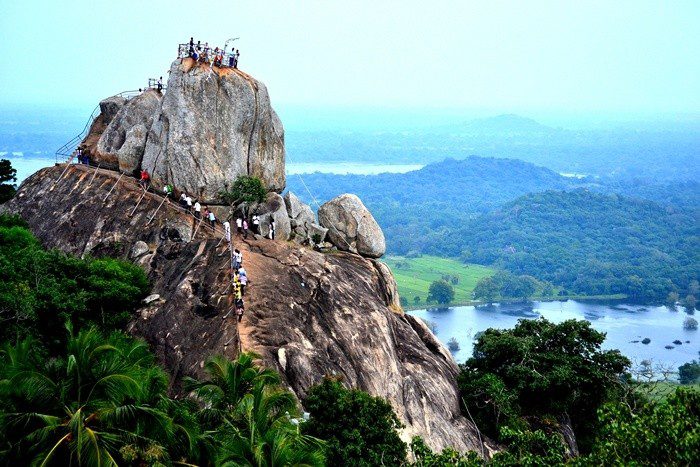
The ancient Mihintale rock (Aradhana Gala) where the transformation of an entire nation to Buddhism, began.
he infamous story of how Sri Lanka came to be a Buddhist country, starts at this location, Mihintale. King Devenampiyathissa, was on a deer hunt when he encountered Arahat Mahinda. Following a conversation between the two, Buddhism was spread throughout the country under the state patronage.
Read more about the story in Mahawansa* ➡ The coming of Mahinda
It is also stated that King Devanampiyathissa, constructed a viharaya and 68 caves for the monks to reside and additions such as the monastery, hospital were constructed ever since. The site is considered as a Solosmasthana* and is worshipped by many. Non-Buddhists also visit the site to explore the ruins and the surrounding areas.
*Solosmasthana – 16 places of veneration
*Mahawansa – The epic poem that elaborates on ancient Sri Lankan history
Quick Facts
- Location: Mihintale (16.3 km from Anuradhapura town) [ Google Maps ]
- Other Names: Missaka Pabbata
- Height: 1,000 ft.
General guidelines to visit temples in Sri Lanka
Buddhist temples are sacred places and people tend to take misdemeanours very seriously. Follow these general guidelines when you’re visiting these holy places. Simply put, be modest.
Please note that some temples may have more strict rules for visitors so always do your research. For an example, monasteries dedicated to meditating monks may require visitors to be silent at all times.
- Always cover your shoulders and knees.
- Avoid wearing the following
- Tank tops
- Wests
- Body Fits
- Unbuttoned shirts
- Shorts
- Short Skirts
- Striped Jeans
- The preferred dress colour is white but any light colour is fine as long as those are not bright.
- Please remove shoes, sandals when you enter a temple premise. Many famous temples have designated stalls to keep your shoes and bags safely.
- DO NOT turn your back to statues of the Lord Buddha when taking photographs.
- DO NOT touch/lean on relics or statues.
- DO NOT smoke or consume alcohol.
- Keep your voice down to a minimum.



